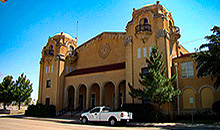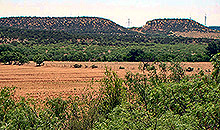Main Menu
Nolan County Data
Nolan County Communities & Places
Genealogy & History Links by USGHN
Important Nolan County Addresses
Sponsors
Nolan County Neighbors
Coke County, Texas Genealogy & History Network
Fisher County, Texas Genealogy & History Network
Jones County, Texas
Mitchell County, Texas
Runnels County, Texas
Scurry County, Texas Genealogy & History Network
Taylor County, Texas
Other Websites
Welcome to Nolan County Texas Genealogy & History Network!
Welcome to the Nolan County, Texas Genealogy & History Network. Our purpose is to provide visitors with free resources for genealogical and historical research. To share your genealogy or history information, send an email to txghn@outlook.com and we will happily include it here. For other Texas Counties, visit the Texas Genealogy & History Network state website and go to the appropriate county. Thanks for visiting and good luck with your research! |
|
About Nolan County, Texas...

Nolan County is in west central Texas. Sweetwater, the county seat and largest population center, is forty-two miles west of Abilene. The county was named for Philip Nolan. The land is predominantly rolling uplands to the north, with plateaus traversed by valleys in the south; altitudes range from 2,000 to 2,700 feet above sea level. The county has very little timber; hackberry, scrubby post oak, cottonwood, and mesquite trees grow along the streams, and Rocky Mountain junipers or scrub cedars grow on the hillsides.
The area of Nolan County had no white settlers until after the Civil War, when buffalo hunters came to the plains. The county was carved from the Young-Bexar territory by the Texas legislature in 1876 and attached to Shackelford County for administrative purposes. Knight's store on Sweetwater Creek was started in a dugout in 1877 to serve buffalo hunters operating in the area. The county's first post office was opened in 1879 in the village of Sweet Water, which was two words until the spelling was officially changed in 1918. The original name of the post office was Blue Goose, derived from a story that the first postmaster ate a blue crane that cowboys told him was a blue goose. By 1880 there were fifty-two ranches in the area, and the economy was dominated by the cattle industry. The agricultural census that year  reported only sixty-four acres devoted to growing corn, the county's most important crop at that time.
reported only sixty-four acres devoted to growing corn, the county's most important crop at that time.
The county was organized after an election held on January 20, 1881, and in April the Nolan County Court declared that Sweetwater was to be the new permanent county seat. The townsite was on the Texas and Pacific Railway, which had built into the area that March. The first newspaper in Nolan County, the Sweetwater Advocate, was published in 1881. Though a blizzard in February 1885 destroyed much of the livestock in the area, settlers continued to move into Nolan County. By 1890 there were 144 ranches and farms. Ranching still dominated the local economy at that time, though sheep had come to outnumber cattle in the area. Meanwhile, 563 acres were planted in corn, 900 acres in oats, and 490 acres in wheat. Hundreds of new settlers moved into the area during the 1890s and early 1900s, establishing towns as they arrived. Roscoe, which grew on the site of a proposed Texas and Pacific station called Vista, was incorporated in 1890, and the town's first newspaper, the Enterprise, was published in 1893. Blackwell, originally named Jamestown, was built around a station on the Kansas City, Mexico and Orient Railway about 1906, and Maryneal was established about the same time. Further settlement was encouraged in 1908, when the Roscoe, Snyder and Pacific Shortline Railway was built to  run fifty miles from Roscoe to Fluvanna. Between 1897 and 1908 fifteen post offices were established in Nolan County.
run fifty miles from Roscoe to Fluvanna. Between 1897 and 1908 fifteen post offices were established in Nolan County.
During this period crop cultivation became central to the economy of the area. The number of farms increased to 293 by 1900 and to 1,160 by 1910. By 1910 over two-thirds of the land was being used for agriculture and 24.2 percent was in improved farm acreage. While about 16,000 cattle and 7,454 sheep were reported in 1910, 33,000 acres were planted in cotton that year, and 21,000 acres were devoted to sorghum. Cotton was by far the most important crop, accounting for almost 72 percent of the county's income derived from cultivation. Many of the new farmers were tenants: sharecropping increased from 20.5 percent of the county's farms in 1900 to 54.7 percent in 1910. Except for a brief recession after World War I, these trends continued between 1910 and 1930, as cotton cultivation continued to expand in the area, particularly during the 1920s. Though cattle and sheep ranching continued to be important to the local economy, the relative significance of ranching in the area continued to decline. By 1930, 80,000 acres in the county were planted in cotton. The number of farms rose from 1,015 in 1920 to 1,351 by 1925 and to 1,514 by 1930. The area's cotton economy was severely shaken during the Great Depression of the 1930s. The number of acres devoted to cotton plunged to 58,000 by 1934 and to 39,000 by 1939. Almost a third of the farmers left their land during the 1930s, and by 1940 only 948 farms remained in Nolan County. Tenant farmers fared the worst, particularly after 1935; the number of tenants in the area dropped from 665 in 1930 to 628 by 1935 and to 440 by 1940.
 While World War II helped to revive the local agricultural economy during the 1940s, by the 1950s farm consolidations, the decline of farm tenancy, and an extended drought caused a drop in population. Though cotton production remained strong and expanded substantially during the 1970s, by 1978 the number of farms in the area had declined to 472. Much of the economic progress in the county since the 1950s has been due to the oil and gas industry. Petroleum was discovered in 1939, but production was minimal at first: in 1948 only 3,353 barrels of crude oil were produced in the county. However, production of crude oil reached 8,315,000 barrels in 1956, 5,331,000 barrels in 1960, 4,900,000 barrels in 1974, 2,400,000 barrels in 1978, and 2,873,000 barrels in 1982. In 1990, 1,965,000 barrels of oil were produced, and by January 1, 1991, 172,176,000 barrels of crude had been taken from county lands since discovery in 1939.
While World War II helped to revive the local agricultural economy during the 1940s, by the 1950s farm consolidations, the decline of farm tenancy, and an extended drought caused a drop in population. Though cotton production remained strong and expanded substantially during the 1970s, by 1978 the number of farms in the area had declined to 472. Much of the economic progress in the county since the 1950s has been due to the oil and gas industry. Petroleum was discovered in 1939, but production was minimal at first: in 1948 only 3,353 barrels of crude oil were produced in the county. However, production of crude oil reached 8,315,000 barrels in 1956, 5,331,000 barrels in 1960, 4,900,000 barrels in 1974, 2,400,000 barrels in 1978, and 2,873,000 barrels in 1982. In 1990, 1,965,000 barrels of oil were produced, and by January 1, 1991, 172,176,000 barrels of crude had been taken from county lands since discovery in 1939.
In 1982, 94 percent of the county was in farms and ranches; about 18 percent of the farmland was cultivated, and 4 percent was irrigated. Cattle, sheep, Angora goats, and hogs were the most important livestock for the economy. Cotton, sorghum, wheat, and hay were the most important crops grown, though local farmers also grew peaches, pecans, sweet potatoes, tomatoes, and watermelons. One of the major industries in Nolan County is gypsum production which began in 1924. The Sweetwater Reporter has been in continuous publication since 1909, and Roscoe's first newspaper, the Enterprise, has been in continuous publication since March 10, 1906. Visitors and residents find recreation at Lake Sweetwater and at Oak Creek Lake. The largest tourist attraction in Nolan County is the Sweetwater Rattlesnake  Round-Up, held each March.
Round-Up, held each March.
The county has a total area of 914 square miles, of which 912 square miles is land and 2 square miles (0.2%) is water. The population recorded in the 1880 Federal Census was 640. It peaked in 1950 at 19,808. The 2010 census recorded 15,216 residents in the county.
Neighboring counties are Fisher County (north), Taylor County (east), Runnels County (southeast), Coke County (south), and Mitchell County (west). The county seat is Sweetwater. Other communities in the county include Blackwell (partial), Roscoe, Maryneal, Nolan, Bitter Creek, and Wastella.
Nolan County, Texas Records
Birth Records - The Texas Department of State Health Services has records from 1903 to present. Records for the last 75 years considered private and will only be provided to certain individuals. To obtain current information on who may obtain a record, how to submit a request and an official request form, see the Texas Department of State Health Services website or write to Texas Vital Records, Department of State Health Services, P.O. Box 12040, Austin, TX 78711-2040.
For older birth records you will have to write to the County Clerk of the applicable county. The existence of birth records prior to 1903 will vary widely from county to county. Local historical societies and genealogy collections in local libraries may be able to provide some information.
Death Records - The Texas Department of State Health Services has records from 1903 to present. Records for the last 25 years considered private and will only be provided to certain individuals. To obtain current information on who may obtain a record, how to submit a request and an official request form, see the Texas Department of State Health Services website or write to Texas Vital Records, Department of State Health Services, P.O. Box 12040, Austin, TX 78711-2040.
Marriage Records - The Texas Department of State Health Services can provide a verification letter of marriage for Texas marriages from 1966 to present. This is NOT a marriage license. To obtain a certified copy of a marriage license you must contact the County or District Clerk in the county or district where the marriage took place.
Local historical societies and genealogy collections in local libraries may be able to provide some information.
Divorce Records - The Texas Department of State Health Services can provide a verification letter of divorce for Texas divorces from 1968 to present. This is NOT a copy of the divorce decree. To obtain a certified copy of a copy of the divorce decree you must contact the County or District Clerk in the county or district where the divorce took place.
Local historical societies and genealogy collections in local libraries may be able to provide some information.




